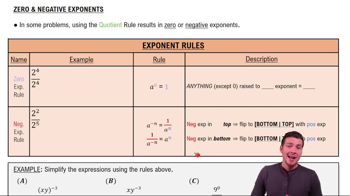Estimating height of a building A surveyor, standing 30 ft from the base of a building, measures the angle of elevation to the top of the building to be 75°. How accurately must the angle be measured for the percentage error in estimating the height of the building to be less than 4%?
Table of contents
- 0. Functions7h 54m
- Introduction to Functions16m
- Piecewise Functions10m
- Properties of Functions9m
- Common Functions1h 8m
- Transformations5m
- Combining Functions27m
- Exponent rules32m
- Exponential Functions28m
- Logarithmic Functions24m
- Properties of Logarithms36m
- Exponential & Logarithmic Equations35m
- Introduction to Trigonometric Functions38m
- Graphs of Trigonometric Functions44m
- Trigonometric Identities47m
- Inverse Trigonometric Functions48m
- 1. Limits and Continuity2h 2m
- 2. Intro to Derivatives1h 33m
- 3. Techniques of Differentiation3h 18m
- 4. Applications of Derivatives2h 38m
- 5. Graphical Applications of Derivatives6h 2m
- 6. Derivatives of Inverse, Exponential, & Logarithmic Functions2h 37m
- 7. Antiderivatives & Indefinite Integrals1h 26m
- 8. Definite Integrals4h 44m
- 9. Graphical Applications of Integrals2h 27m
- 10. Physics Applications of Integrals 3h 16m
- 11. Integrals of Inverse, Exponential, & Logarithmic Functions2h 31m
- 12. Techniques of Integration7h 41m
- 13. Intro to Differential Equations2h 55m
- 14. Sequences & Series5h 36m
- 15. Power Series2h 19m
- 16. Parametric Equations & Polar Coordinates7h 58m
4. Applications of Derivatives
Differentials
Problem 4.2.15aiii
Textbook Question
Roots (Zeros)
a. Plot the zeros of each polynomial on a line together with the zeros of its first derivative.
iii. y = x³ − 3x² + 4 = (x + 1)(x − 2)²
 Verified step by step guidance
Verified step by step guidance1
First, identify the zeros of the polynomial y = x³ − 3x² + 4. To do this, set y equal to zero and solve for x. The polynomial is factored as (x + 1)(x − 2)², so the zeros are x = -1 and x = 2.
Next, find the first derivative of the polynomial y = x³ − 3x² + 4. Use the power rule to differentiate each term: the derivative of x³ is 3x², the derivative of -3x² is -6x, and the derivative of 4 is 0. Therefore, the first derivative is y' = 3x² - 6x.
Set the first derivative equal to zero to find its zeros: 3x² - 6x = 0. Factor out the common term, which is 3x, resulting in 3x(x - 2) = 0. The zeros of the derivative are x = 0 and x = 2.
Plot the zeros of the original polynomial and its derivative on a number line. The zeros of the polynomial are x = -1 and x = 2, and the zeros of the derivative are x = 0 and x = 2. Note that x = 2 is a common zero.
Consider the behavior of the function and its derivative around these zeros. The zero at x = 2 is a repeated zero in the polynomial, indicating a change in concavity or a local extremum. The zero at x = 0 in the derivative suggests a potential inflection point or change in slope.
 Verified video answer for a similar problem:
Verified video answer for a similar problem:This video solution was recommended by our tutors as helpful for the problem above
Video duration:
3mPlay a video:
Was this helpful?
Key Concepts
Here are the essential concepts you must grasp in order to answer the question correctly.
Roots (Zeros) of a Polynomial
The roots or zeros of a polynomial are the values of x for which the polynomial equals zero. For the polynomial y = (x + 1)(x − 2)², the zeros are x = -1 and x = 2. These points are where the graph of the polynomial intersects the x-axis.
Recommended video:

Introduction to Polynomial Functions
First Derivative and Critical Points
The first derivative of a function, denoted as y', represents the rate of change or slope of the function. Finding the zeros of the first derivative helps identify critical points, which are potential locations for local maxima, minima, or points of inflection. For y = x³ − 3x² + 4, the derivative is y' = 3x² - 6x, and its zeros are found by solving 3x(x - 2) = 0, giving x = 0 and x = 2.
Recommended video:

Critical Points
Graphical Representation of Zeros
Plotting the zeros of a polynomial and its derivative on a number line helps visualize the relationship between the function and its rate of change. The zeros of the polynomial indicate where the graph crosses the x-axis, while the zeros of the derivative indicate where the slope is zero, marking potential turning points or changes in concavity.
Recommended video:
Guided course

Zero and Negative Rules

 5:53m
5:53mWatch next
Master Finding Differentials with a bite sized video explanation from Patrick
Start learningRelated Videos
Related Practice
Textbook Question
